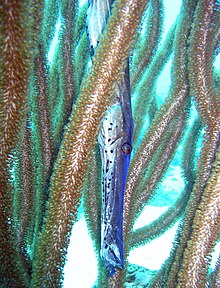| Syngnathiformes Temporal range:
| |
|---|---|

| |
| Trumpetfish (Aulostomus maculatus: Aulostomidae), head in natural pose | |
| Scientific classification | |
| Domain: | Eukaryota |
| Kingdom: | Animalia |
| Phylum: | Chordata |
| Class: | Actinopterygii |
| (unranked): | Acanthomorpha |
| Superorder: | Acanthopterygii |
| Clade: | Percomorpha |
| Order: | Syngnathiformes |
| Type species | |
| Syngnathus acus | |
| Families | |
|
See text | |
The Syngnathiformes /ˈsɪŋ(ɡ)nəθɪfɔːrmiːz/ are an order of ray-finned fishes that includes the leafy seadragons, sea moths, trumpetfishes and seahorses, among others.[2]
These fishes have generally elongate, narrow bodies surrounded by a series of bony rings, with small, tubular mouths. The shape of their mouth—at least, in syngnathids—allows for the ingestion of prey at close range via suction.[3] Many species of Syngnathiformes also employ strategic camouflage (such as cryptic coloration and overall physical form) to hunt successfully and gain closer access to prey, as well as to protect themselves from larger predators. Several groups, for example, live among seaweed, not only swimming with their bodies aligned vertically (to blend in with the floating plant matter) but have also developed physical features that mimic the seaweed. The pygmy seahorses are among the smallest of all syngnathids, with most being so tiny—and mimicking the specific coral they spend their lives on—that they were only recently described by scientists.
The most defining characteristic of Syngnathiformes is their reproductive and sexual system, in which syngnathid males become "pregnant" and carry the embryonic fry. The males house the fertilized eggs in an osmo-regulated brood pouch, or (in some species) adhere them to their tail, until the eggs reach maturity.
The name Syngnathiformes means "conjoined-jaws". It is derived from Ancient Greek syn (συν, "together") + gnathos (γνάθος, "jaw"). The ending for orders, "-formes", is derived from Latin, and indicates "of similar form".
- ^ Cite error: The named reference
:0was invoked but never defined (see the help page). - ^ FishBase (2005): Order Summary for Syngnathiformes. Version of 2005-FEB-15. Retrieved 19 Aug 2008.
- ^ Langley, Liz (26 November 2013). "Why Does the Seahorse Have Its Odd Head? Mystery Solved – News Watch". Newswatch.nationalgeographic.com. Archived from the original on November 27, 2013.